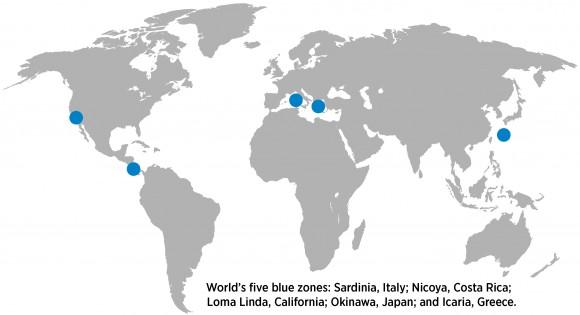Alemao, a former family and consumer sciences educator, remembers feeling more than a little amazed by the book. “I thought, wow, this is everything I used to teach, like food and nutrition, marriage and family, and consumer education, plus all the evidence and research to support it. I couldn’t believe that it was all here, all condensed into one book.”

“Volunteering gives people purpose and a reason to get up in the morning. And people with purpose live longer—that’s one of the Power 9.”
The Power 9, as outlined in “The Blue Zones,” are the nine lifestyle principles that Buettner and his team documented during extensive research trips to the world’s five blue zones: Sardinia, Italy; Nicoya, Costa Rica; Loma Linda, California; Okinawa, Japan; and Icaria, Greece.
These principles, Buettner explains, are common elements of the lifestyle and dietary habits and overall outlook the centenarians share in each location he visited. They’re a recipe for longevity, he says. “But it’s an a la carte menu; you don’t have to do all of them.”
Here’s how you can apply these proven principles to your life—or even your community.
1. Move Naturally
Be active without having to think about it. Staying active doesn’t necessarily mean just going to the gym a few times a week. It means making low-intensity physical activity a daily part of life, and little changes make a big difference. “One common denominator I noticed right away in the five Blue Zones is that they all have fairly hilly terrain,” Buettner explained. “So walking these hills is part of their everyday lives, and it’s serious physical activity.”The point is to keep moving and to make sure you weave aerobic, balance, and muscle-strengthening activities into your daily routine, whether you’re at work or play.
2. Practice ‘Hara Hachi Bu’
Painlessly cut calories by 20 percent. The Confucian-inspired adage “hara hachi bu” is a reminder to stop eating when your stomach is 80-percent full. This means you eat until you no longer feel hungry, but stop before you’re completely stuffed.When you cut calories, you lose weight. Even shedding only 10 percent of your body weight can lower your blood pressure and cholesterol level, which reduces your risk of heart disease. Cutting calories, Buettner says, may also reduce cellular damage from free radicals.
But diets are hard to stick to, so the secret—besides choosing healthier, whole foods—is to learn how to consume less at each meal.

3. Take a Plant Slant
Avoid meat and processed foods. “Another common denominator of centenarians in the world’s five Blue Zones is that they’re all cut off from food culture influences,” Buettner said, so they’ve never really had the chance to eat processed foods or salty snacks. And they rarely eat meat, either because they’ve made a choice to avoid it or because they don’t have access to it. Buettner’s research showed that the centenarians’ longevity diets were based on beans, whole grains and vegetables (usually grown in their own gardens). One of the keys, he says, is to find a balance—everything in moderation.4. Enjoy the Grapes of Life
Drink red wine (in moderation). A drink or two a day appears to reduce stress and the effects of chronic inflammation, Buettner says, but there are risks to drinking excessive amounts of alcohol, such as a possible increase in breast cancer risk; damage to the brain, liver, and other organs; and a higher risk of accidents.Buettner found that for those who have a healthy relationship with alcohol, a glass of red wine per day offers numerous health benefits, especially if it’s red wine, which contains polyphenols that are shown to combat arteriosclerosis. Choose a high-quality, dark-red wine (although one drink per day of beer or spirits may also offer some benefits).
5. Find Purpose
Take time to see the big picture. Buettner’s research showed that many centenarians credit their longevity to having a sense of purpose or a defined goal—“why I wake up in the morning.”This sense of purpose can be for any number of reasons, like having a family you often spend time with, a job you enjoy, a hobby you can’t get enough of, or a fulfilling mission, like volunteering. Having a sense of purpose reduces stress, keeps the brain sharp, and can decrease your risk of Alzheimer’s disease, arthritis, and stroke.
6. Downshift
Take time to relieve stress. In his book, Buettner cites a theory by Italian endocrinologist Dr. Claudio Franceschi, who maintains that stress causes inflammation and that “the negative effects of inflammation build up to create conditions in the body that may promote age-related diseases.”Slowing down life’s pace, Buettner says, not only keeps inflammation down but also “ties together so many of the other lessons—eating right, appreciating friends, finding time for spirituality, making family a priority, and creating things that bring purpose.”
7. Belong
Participate in a religious community. In his book, Buettner observed that all centenarians belonged to a religious community. “The simple act of worship is one of those subtly powerful habits that seems to improve your chances of having more good years,” Buettner wrote. “It doesn’t matter if you are Muslim, Christian, Jewish, Buddhist, or Hindu.”This lesson integrates with other lessons, he explains, because people who belong to a spiritual community are more likely to engage in healthy behaviors, have a positive sense of well-being, and are able to “relinquish the stresses of everyday life to a higher power.” Sitting quietly through a service, he says, is also a form of meditation, which helps to relieve stress.
If you’re already a member of a community, Buettner advises becoming even more involved, such as by volunteering.


Friends Read Free